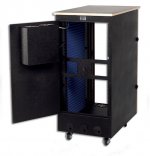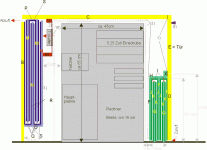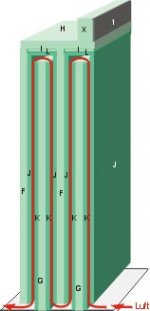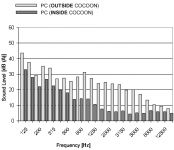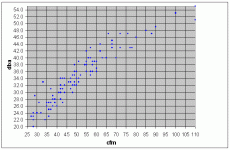Aluminium case makes it all even worse as they are usually relatively lightweight compared to steel cases and side plates and entire chassis resonates very easily. Attach couple of fast SCSI drives and you definetely have enough noise.mali_aber said:
I have removed my hd rack from chassis and supported it with pieces of rubber foam plates. It really makes difference.
This way HD cooling is also as good as before, they are still bolted on to their hd rack for cooling.(and there is quiet 80mm fan)
Your Lian-Li is probably so crowded that there is insufficient space for this kind of like solution. Adding some damping to case sideplates and all free metal parts gives some benefit, 4mm thick bitumium mat works well for "deading" 🙂
You can try if there is possible reduction in resonance noises by squeezing your case sidewalls from center betweeen your hands. Some cases are resonating like rattlesnake, all metal parts with semi-ridig contact to each other and drumming together.
Anyways, your power supply is probably your biggest bugger if it is 1kW++ server model....
Quiet fan does not necessarily mean less airflow. By better blade design you can reduce turbulence and noise and even improve airflow.
hi mzzj
i guess this enclosure will be 1.6m high x 0.9m wide x 1.1m deep minimum. it will weight more than 150-200kg (450lb).
power supply consists of 2 independent modificated 510w supplies. that lianli is very big case, but i will replace it with 2 rackmount ipc cases.
richie, i agree that there are fans and fans, so some slower fans may move more air due to proper design. on the other hand, there is coreation betwee fan noise nad ammount of air they move, pls see this pic.
i guess this enclosure will be 1.6m high x 0.9m wide x 1.1m deep minimum. it will weight more than 150-200kg (450lb).
power supply consists of 2 independent modificated 510w supplies. that lianli is very big case, but i will replace it with 2 rackmount ipc cases.
richie, i agree that there are fans and fans, so some slower fans may move more air due to proper design. on the other hand, there is coreation betwee fan noise nad ammount of air they move, pls see this pic.
Attachments
Hi
Insulated cabinets can be built like you've shown in the examples. I'll come to that in a bit.
If you have so much LF inside the enclosure I see car damping materials like drywall and carpet are good blocking materials. Apply a couple of layers to the inside. Please remember that this will raise your temperatures a bit.
The electrical charts you refer to are dissipation figures, and the total processor consumption. How much the processors are meant to thermally dissipate are the TDP (Thermal Design Power) but that is the full load (100% usage). Total power draw is Vcore x max amps, but that is also at 100% load. On a 24/7 basis you may not need to dissipate all of it. In your case that figure would be 87 watts of heat at full load. With a 0.3 C/W heatsink, that would put the HSF at 26 degrees above ambient.
I would say with your kind of work plan for a 50% duty cycle, that is, full load 50% of the time. I would imagine that compositing/rendering is when the CPUs are at full bent, otherwise at 20-30% usage. You'll have to analyse it yourself, though.
There's a pretty dramatic increase in noise and noise frequency after closing the cabinet/going outside the cabinet. This would be fan and airflow noise. Unless you do install quieter fans and/or ducting, maybe there is no other solution for this noise.
http://www.ocforums.com/showthread.php?t=362782&highlight=Ducts Very ugly chimney, but it does the job. I'm sure you can do better work with acrylic/alu if you've got some DIY skills.
http://www.ocforums.com/showthread.php?t=70679&highlight=Ducts This is a nice sticky that may give you a few additional insights. There are lots of nice ideas in there, like cutting out fan grills, that may be practical for you.
Your case is fairly popular. Searching for mods on it will give you ideas. Don't have to implement what you don't think is sane. Some good sites with helpful BBS are www.ocforums.com and www.xtremesystems.com These kind of guys are pushing their systems beyond the limit, which you are not going to do, but they also need to keep their systems cool. I am sure you wil find lots of different ideas to try.
I would have said silentpcreview but there the focus is on quiet, not performance. Maybe you can get some equipment ideas from there, like which fans. I wold still recommend a change of fans, seeing as the bulk of your noise is on the outside, and it's the irritating bit.
About your PS fans, you don't have much of an option unfortunately unless you're determined, to change them. Ducting the exhausts will cut down the noise completely, maybe it's worth a try. I would urge you to look at the chimney layout to keep it cool.
Once you have the PC running a little quieter (Damping, fan change, etc) and cooler (ducting, chimney) It's time to look at the drive enclosure. Since your drives are in a separate case, these basic mods might help:
Cut out fan grills from the fan holders. That will be quite a difference to start with.
Use a fan controller to cut down fan speed. Arrive at a good balance between temperature and fan speed/noise.
Damp the inside thoroughly. Car carpet and drywall liner makes an excellent noise damper.
Radical idea. Mount fans under each of the drives (if you get space) and run them at 7 volts or with a controller, 5.5 volts. Then you can get away with just one 80 mm exhaust. Seal off the rest of the fan holes.
Last the soundproof enclosure.
It looks to me the ones you've shown are more organising cabinets than soundproofing enclosures. You may have to dig a little deeper.
Start with material choice. 450 lbs means thinking of thick wooden base. Industrial strength feet. Or think steel extrusions and panels, with damping and sealing to keep the noise out.
Your main problem is how to get cool air into the system enclosure. Unless you plan to watercool the whole thing, you'll have to duct in the fresh stuff from somewhere.
Condensation will happen if you let warm air into a cool area. http://www.ocforums.com/showthread.php?t=401635&highlight=Ducts post #6 explains condensation. Critical thing is to seal it off, and yes, it is not without risk. So don't play with it if you're not comfortable. But as long as the air is always cool, you should be OK. The problem would happen if you let the cold air in after the PC is warmed up and still has hotspots.
The idea is to get some air into the system that is cooler than ambient, so overall temps stay in control. I would not advise to put an air conditioner if it is more noisy than the PC, but a small split or cassette makes practically no noise. A window unit would be a serious racket.
Then damping the enclosure, using more drywall and carpet. This will help a bit if you are using strong and stiff materials to make the enclosure.
Last planning for the exhaust. I am quite taken with the idea of leaving the whole back open initially and then using a tall tapering chimney to exhaust the air upwards, in the process sealing off the back. Keep the chimney removable from the frame and use gaskets to seal the airflow.
I only want to make one point on fans and fan noise.
There are two sources of fan noise. One is the fan's self-noise or mechanical noise. Good engineering will minimise this. Some models of fans are specifically aimed at reducing noise, but only mechanical noise. Papst, Panasonic and Thermaltake all have a 'silent' line of fans in addition to their main lines.
The second source is the air noise, caused by the movement of air. We all know that exhaling is quieter than whistling. Small apertures increase turbulence and noise. Large apertures tend to disperse airflow, making cooling less effective, but more quiet. So a compromise will have to be reached.
The other thing is fan size. Larger fans move larger amounts of air for a given rpm, and so will need to move at lower rpm (and generate less noise) to keep the same amount of airflow. 120 mm units are kings here, at 600-900 rpm they can move more air than two 80 mm fans running at much higher revs. Wherever possible try to fit larger fans to get a drop in noise.
Insulated cabinets can be built like you've shown in the examples. I'll come to that in a bit.
If you have so much LF inside the enclosure I see car damping materials like drywall and carpet are good blocking materials. Apply a couple of layers to the inside. Please remember that this will raise your temperatures a bit.
The electrical charts you refer to are dissipation figures, and the total processor consumption. How much the processors are meant to thermally dissipate are the TDP (Thermal Design Power) but that is the full load (100% usage). Total power draw is Vcore x max amps, but that is also at 100% load. On a 24/7 basis you may not need to dissipate all of it. In your case that figure would be 87 watts of heat at full load. With a 0.3 C/W heatsink, that would put the HSF at 26 degrees above ambient.
I would say with your kind of work plan for a 50% duty cycle, that is, full load 50% of the time. I would imagine that compositing/rendering is when the CPUs are at full bent, otherwise at 20-30% usage. You'll have to analyse it yourself, though.
There's a pretty dramatic increase in noise and noise frequency after closing the cabinet/going outside the cabinet. This would be fan and airflow noise. Unless you do install quieter fans and/or ducting, maybe there is no other solution for this noise.
http://www.ocforums.com/showthread.php?t=362782&highlight=Ducts Very ugly chimney, but it does the job. I'm sure you can do better work with acrylic/alu if you've got some DIY skills.
http://www.ocforums.com/showthread.php?t=70679&highlight=Ducts This is a nice sticky that may give you a few additional insights. There are lots of nice ideas in there, like cutting out fan grills, that may be practical for you.
Your case is fairly popular. Searching for mods on it will give you ideas. Don't have to implement what you don't think is sane. Some good sites with helpful BBS are www.ocforums.com and www.xtremesystems.com These kind of guys are pushing their systems beyond the limit, which you are not going to do, but they also need to keep their systems cool. I am sure you wil find lots of different ideas to try.
I would have said silentpcreview but there the focus is on quiet, not performance. Maybe you can get some equipment ideas from there, like which fans. I wold still recommend a change of fans, seeing as the bulk of your noise is on the outside, and it's the irritating bit.
About your PS fans, you don't have much of an option unfortunately unless you're determined, to change them. Ducting the exhausts will cut down the noise completely, maybe it's worth a try. I would urge you to look at the chimney layout to keep it cool.
Once you have the PC running a little quieter (Damping, fan change, etc) and cooler (ducting, chimney) It's time to look at the drive enclosure. Since your drives are in a separate case, these basic mods might help:
Cut out fan grills from the fan holders. That will be quite a difference to start with.
Use a fan controller to cut down fan speed. Arrive at a good balance between temperature and fan speed/noise.
Damp the inside thoroughly. Car carpet and drywall liner makes an excellent noise damper.
Radical idea. Mount fans under each of the drives (if you get space) and run them at 7 volts or with a controller, 5.5 volts. Then you can get away with just one 80 mm exhaust. Seal off the rest of the fan holes.
Last the soundproof enclosure.
It looks to me the ones you've shown are more organising cabinets than soundproofing enclosures. You may have to dig a little deeper.
Start with material choice. 450 lbs means thinking of thick wooden base. Industrial strength feet. Or think steel extrusions and panels, with damping and sealing to keep the noise out.
Your main problem is how to get cool air into the system enclosure. Unless you plan to watercool the whole thing, you'll have to duct in the fresh stuff from somewhere.
Condensation will happen if you let warm air into a cool area. http://www.ocforums.com/showthread.php?t=401635&highlight=Ducts post #6 explains condensation. Critical thing is to seal it off, and yes, it is not without risk. So don't play with it if you're not comfortable. But as long as the air is always cool, you should be OK. The problem would happen if you let the cold air in after the PC is warmed up and still has hotspots.
The idea is to get some air into the system that is cooler than ambient, so overall temps stay in control. I would not advise to put an air conditioner if it is more noisy than the PC, but a small split or cassette makes practically no noise. A window unit would be a serious racket.
Then damping the enclosure, using more drywall and carpet. This will help a bit if you are using strong and stiff materials to make the enclosure.
Last planning for the exhaust. I am quite taken with the idea of leaving the whole back open initially and then using a tall tapering chimney to exhaust the air upwards, in the process sealing off the back. Keep the chimney removable from the frame and use gaskets to seal the airflow.
I only want to make one point on fans and fan noise.
There are two sources of fan noise. One is the fan's self-noise or mechanical noise. Good engineering will minimise this. Some models of fans are specifically aimed at reducing noise, but only mechanical noise. Papst, Panasonic and Thermaltake all have a 'silent' line of fans in addition to their main lines.
The second source is the air noise, caused by the movement of air. We all know that exhaling is quieter than whistling. Small apertures increase turbulence and noise. Large apertures tend to disperse airflow, making cooling less effective, but more quiet. So a compromise will have to be reached.
The other thing is fan size. Larger fans move larger amounts of air for a given rpm, and so will need to move at lower rpm (and generate less noise) to keep the same amount of airflow. 120 mm units are kings here, at 600-900 rpm they can move more air than two 80 mm fans running at much higher revs. Wherever possible try to fit larger fans to get a drop in noise.
- Status
- Not open for further replies.
- Home
- General Interest
- Everything Else
- sound insulation cabinet for noisy computer
